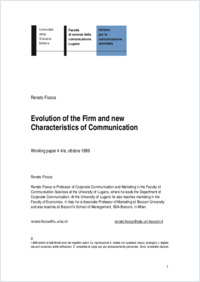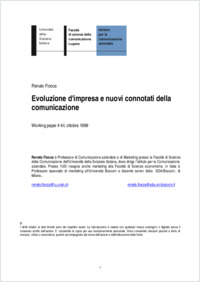Evolution of the firm and new characteristics of communication
- Fiocca, Renato Istituto per la comunicazione aziendale (ICA), Facoltà di scienze della comunicazione, Università della Svizzera italiana, Svizzera
-
1999
26 p
English
A unique characteristic of corporate communication is its versatility. With respect to many other organizational functions and competencies, corporate communication tends to adapt to the firm’s characteristics and to the environment, in addition to the circumstances and situations characterizing its use. This is not at all surprising when one of the fundamental roles of communication is considered: to favor contact among parts of a whole. In particular, communication in business contexts has the task of favoring and developing relations among the firm and its business environment (market, technological, financial, social, etc.) and relationships within the firm (specifically, with and among employees). In addition, corporate communication is in turn composed of extremely heterogeneous tools, which make use of various kinds of technological support to obtain different specific results. That is why this versatile and diversified discipline occasionally runs the risk of being confusing, obviously detrimental to the understanding and harmonic development of the discipline itself. This paper presents different meanings assigned to corporate communication in relation to different orientations in the theory and practice of business administration. The presentation of three research models, each focusing on a specific theory in business administration and corporate communication, highlights the limitations that can come about when there is a partial vision of the analysis of a global phenomenon such as corporate communication. The main focus is to present a key to determining the diverse evaluations of communication that are proposed in both literature and practice. By putting together diverse elements of the three orientations, it can be seen that the different meanings of communication can lead to firms’ different priorities. Firms can be primarily interested in obtaining a competitive advantage, satisfying customers, or generating new and greater resources of trust and loyalty. In reality, these three orientations are not conflicting, but strongly complementary. A firm obtains a competitive advantage if it is able to satisfy its stakeholders and, in this way, obtain an increase in its stock of loyalty.
- Language
-
- English
- Classification
- Information, communication and media sciences
- License
-
License undefined
- Open access status
- green
- Identifiers
-
- RERO DOC 5238
- ARK ark:/12658/srd1318073
- Persistent URL
- https://n2t.net/ark:/12658/srd1318073
Other files
Statistics
Document views: 163
File downloads:
- Texte intégral: 220
- Texte intégral: 551

